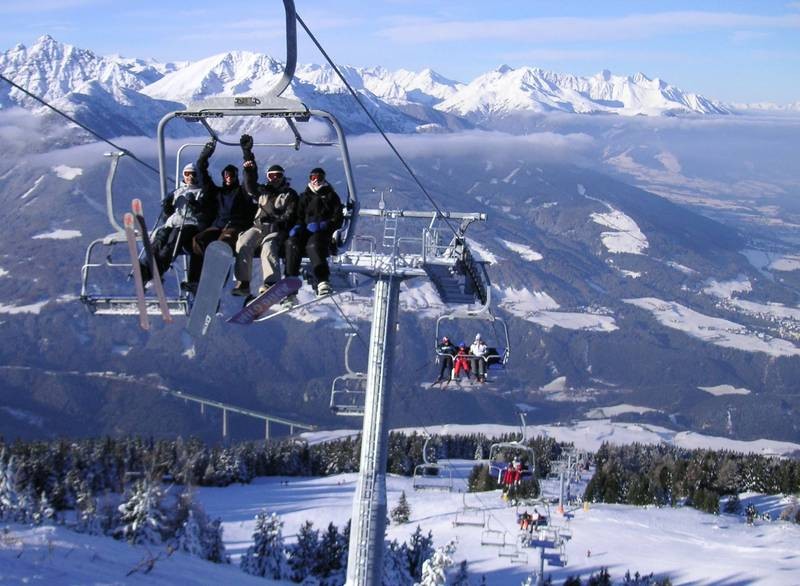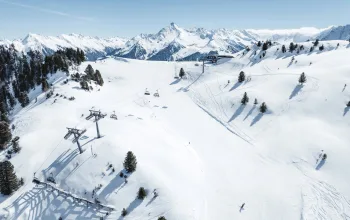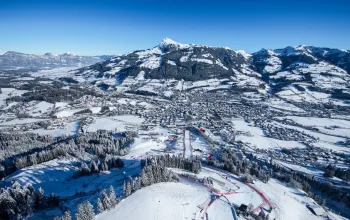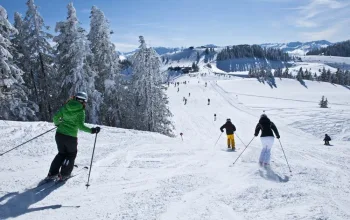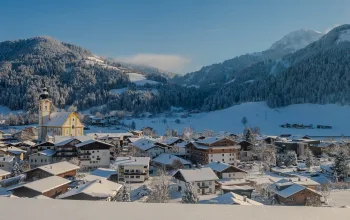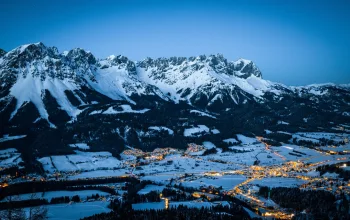Pretty village above the beautiful city of Innsbruck and was the Olympic centre at the 1976 Olympics where Franz Klammer took gold. The regional lift pass covers other areas around the Olympic capital and the Stubai glacier. There are a total of nine ski areas.
Mountain
Beginners will enjoy Igls's local skiing on the Palschertkofel, with the nursery slopes right next to the village centre (there are more up the mountain reached by cable car if village level snow cover is inadequate, although snow making has appeared in recent seasons). After you have mastered the basics, the long blue from the top of the two stage gondola (due to be replaced by a high speed quad shortly) down the wide run through the trees, is something solid to progress to. You may be able to tackle the red on which Klammer won his medal by the end of your first week if things go well! You'll need to take the rather aged single chair right to the top to access the full vertical. Intermediates will find a day or two of enjoyment on the two long runs, but are likely to be drawn to the opportunities in the surrounding resorts, all included on the Innsbruck 'Glacier Lift Pass', including as it does the glacier lifts on the Stubai, open 365 days a year for guaranteed skiing. The areas are scattered at distances varying from 15 to 45 minutes travel time from Igls and they surround the city of Innsbruck like numbers around a clock face. A free scheduled ski bus links Igls to the other areas. The high value pass includes, going clockwise from Igls, first neighbours Fulpmes and Neustift with the Stubai Glacier beyond then, across the valley and back closer to Innsbruck, there's Axamer Lizum and the Seegrube area to the north of the city. The premium "Super Ski" variant on the basic lift pass, throws in a day's skiing in Kitzbühel and St. Anton, including the one-hour transfer, and gives Innsbruck visitors access to a total of 200 lifts serving 500 kilometers (313 miles) of downhill trails. Innsbruck has been unfairly branded a wimpy destination for skiing, although it is true that the mountains offer predominantly intermediate territory. However, only a few very skilled skiers are up to the narrow steep crêtes and couloirs atop the Hafelekar (in the Seegrube-Nordkette sector), and locals can point out lots of other challenges at Axamer Lizum and Stubai. A funicular from the city centre runs to the Hungerburg plateau and a two-stage gondola carries on to the Seegrube-Hafelkar area on the Nordkette mountain range. Midway, the Seegrube is good beginner and intermediate terrain, favoured by Innsbruckers on their lunch-breaks, and there is a halfpipe. Signs warn only very skilled skiers to proceed upward to the top. The main Olympic ski site, Axamer Lizum, has a relatively modern funicular and 9 ski lifts serving a 762m. (2,477 ft.) vertical. There is a variety of terrain, mainly of the intermediate persuasion, although there's some challenge in emulating the championship courses. There are two much longer runs to be reserved for day's end (not served by lifts) which end in the neighbouring villages. The Mutter Alm has a 858 m. (2,970 ft.) vertical served by a two-section gondola, one chairlift and three draglifts. The runs are gentle beginner and low intermediate fare. With 1,367 m. (4,442 ft.) of vertical, the Glungezer area at Tulfes is best for long cruising runs. At a peak altitude of 3,240 m (10,532 ft), the Stubai glacier area has 1,474 m. (4,790 ft.) vertical spread over a broad area served by 19 lifts. In bad weather, conditions can be severe, but the area guarantees skiing in Innsbruck throughout the winter (and the summer!). Stubai offers trails for all skill levels and some challenging off-piste runs. Innsbruck's full-service ski rental is a pleasant surprise.
Families
Bobos Adventure Outdoor Kindergarten, run by the ski school in the high season only (so check dates direct in advance!), accepts snow loving children aged four and up at its base at the Patscherfkofel Cable Car. Children may be booked in for any period from an hour onwards, with the facility open all day every day. Although cities are rarely child-friendly, Innsbruck is better than most, with most of the busy main roads outside the city. There is plenty of parkland dotted around and trams to hop on and off to get you around. Children enjoy the Alpine Zoo, where indigenous species can be seen in environments similar to their native habitats. Most are also enchanted by the Swarovski Crystal Worlds in nearby Wattens, a three-dimensional adventure of crystal, light, and sound.
Eating Out
The ten restaurants in Igls provide an invariably high standard of cuisine and service. The Sporthotel has two restaurants both highly regarded for the gourmets in your party. The Hotel Batzenhäsl's restaurant specialises in local cuisine and the La Fontana restaurant at the Römerhof has a reputation for excellent meals. All the other restaurants are also hotel based except for the four on-mountain establishments, the Dorfstube and Milchstüberl. As with all other things in Igls you have the option of popping down to Innsbruck for great choice, which ranges from international fast food chains to gourmet extravaganzas.
Apres
There are around a dozen bars and restaurants to choose from in Igls. Central choices include the Bon Alpina, the rustic bar of the Agidihof or the original Tyrolean wine stüberl of the Batzenhäusl. The luxurious five star Schlosshotel features a Hunters Lodge cocktail bar with log fire whilst the Gruberhof has a conservatory style bar. The atmosphere in general is sophisticated but friendly. For a more raucous night life, or just more variety, you need to head down to the big city. With its major university, Innsbruck has a student population that enlivens the evenings there and dozens of bars to cater for them. The centre of activity is in the Old Town in the bars and cafés on the square and along the side alleys. Zwolver and the Piano Bar are popular. There is always an active crowd for drinks, good food, and dancing at the Hofgarten Café, a pavilion in the old palace garden. Later the action moves to Filou, or one of the dozens of other hot spots. I nnsbruck's state-of-the-art Casino offers stunning evening mountain views and modern murals to accompany slot machines, roulette, and blackjack. If you stay out until after the funicular and buses stop running it's a relatively inexpensive taxi ride back up the hill to Igls. The late night dancing spot in Igls itself is the disco in the five star Sporthotel.
Boarding
Although Igls has no terrain parks or manufactured features, the fact that you can get right to the top of the long vertical by gondola and chair makes it a reasonably good choice for the less demanding 'boarder. There are some natural hits at the edges of the trails which are wide open cruisers. Innsbruck as a whole has worked hard successfully to position itself as a prime 'boarding venue. In early March, the Seegrube halfpipe is extended and enhanced to challenge the world's top 'boarders in the "Innsbruck Extreme" contest. Accompanied by members of the large local student population, 'boarders find lots of on-and-off-piste challenge in virtually all the Innsbruck areas.


